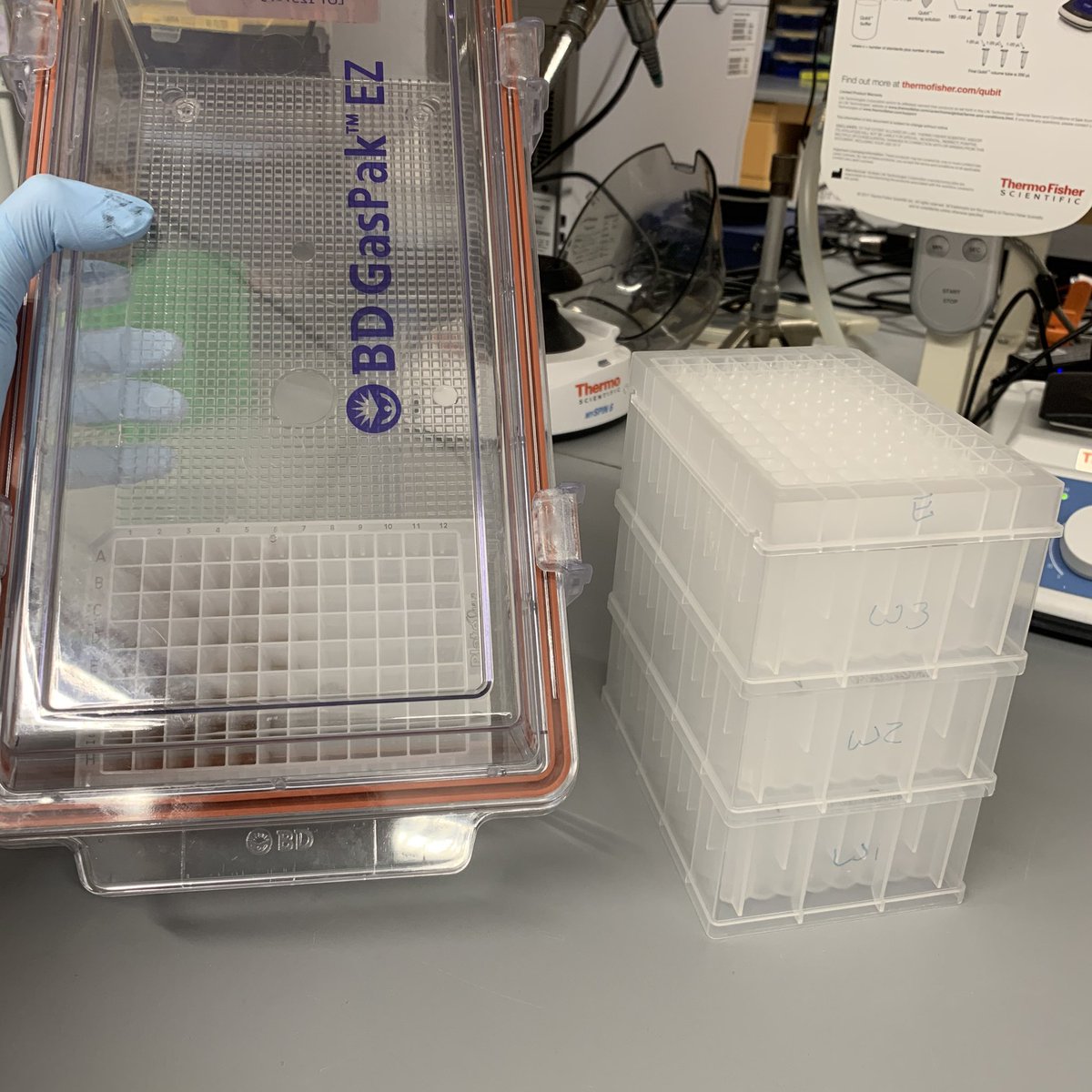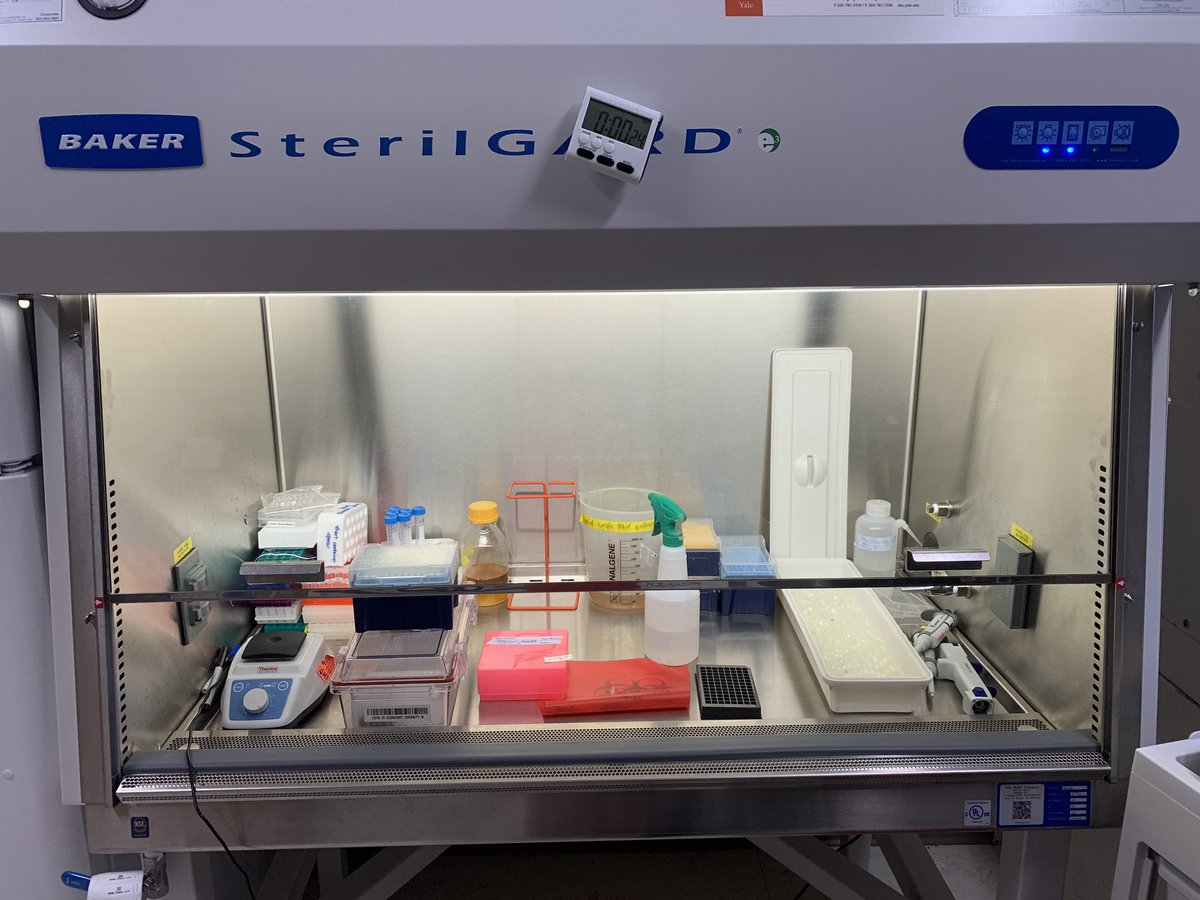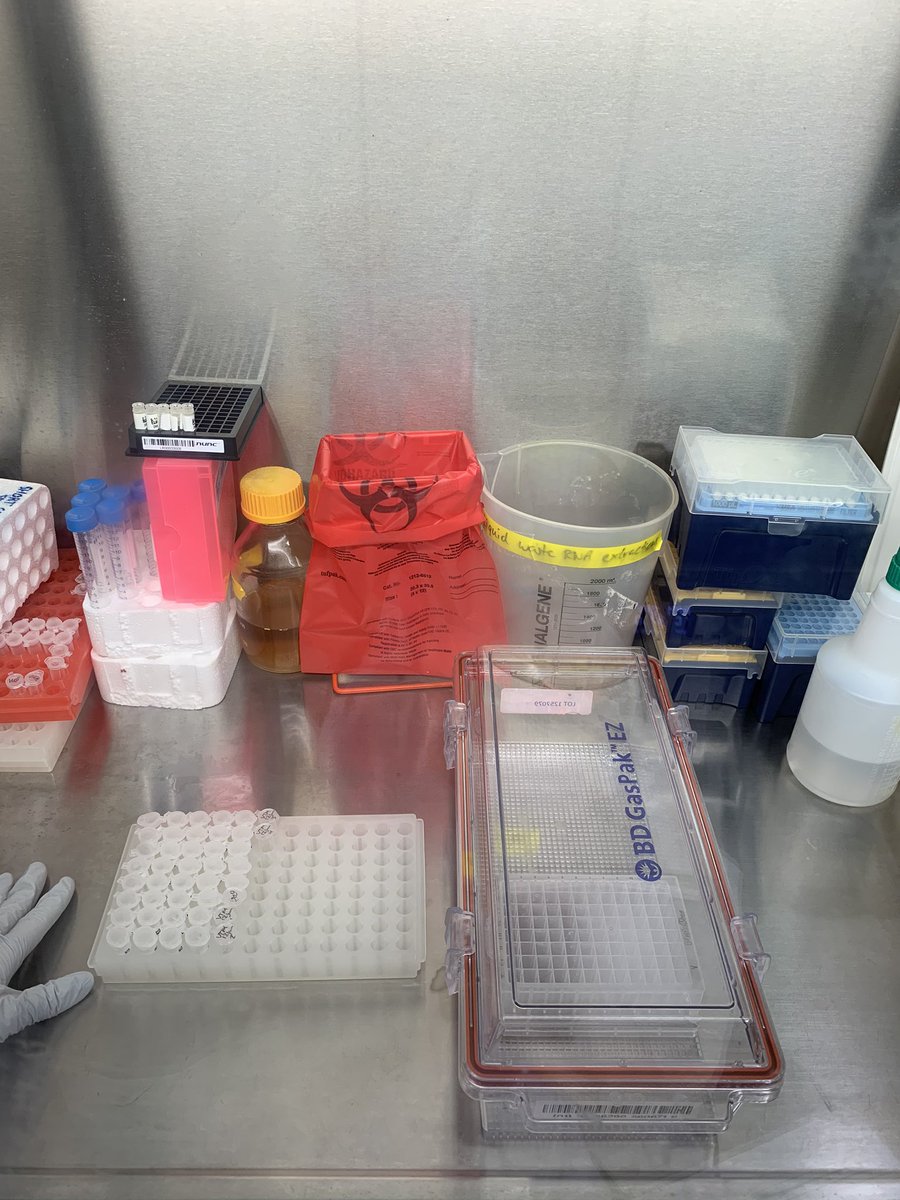Since I’m on the solo Saturday RNA extraction shift, which has fewer samples and a more lenient timeline, I figured I could walk y’all through how we extract viral RNA for our #COVID19 testing at @YaleEMD while my extraction runs! [thread]
First, some basics: we use a magnetic bead-based extraction approach, which uses tiny magnetic beads tagged with small molecules to attract DNA/RNA. Here’s a concise walkthrough of the basic steps of this for another mag bead extraction kit: [1/n]
Samples from YNHH inpatients and healthcare workers enrolled in our study are collected and processed by a team led by Cate Muenker, @arnaucasanovas, and @AJMooreHealth - some of each sample gets stored, and extractors get ~1mL, usually of saliva + nasopharyngeal swabs. [2/n]
Once we have a sample count, we can set up plates for the run. The sample plate (left) is what we add samples to directly, and has beads and a binding solution. Wash 1= detergent, 2+3=80% ethanol washes (help separate RNA from solution), + elution buffer (to collect RNA in @ end)
(the extraction machine is yelling at me that it is Done, so I will return to this after I unload and process its contents)
To resume: it’s easiest to load the non-sample plates into the extraction robot at this point. Basic robot components: magnetic pipette tips/base, and a carousel to hold the various plates that cycle past the tips. [5/n]
Now it’s sample loading time! I start by moving everything I need into the biosafety cabinet (samples, sample plate, pipette tips, waste bag) and then put samples in a rack in the layout I’ll load them into the plate.
(and before the self-appointed internet biosafety police swoop down on me for the second pic: I was copying a platemap - a table of which sample went in each well - with my right hand outside of the BSC beforehand. I was not touching samples and then my phone) [7/n]
Next, we mix samples using a vortex machine (demo video shows one outside the BSC mixing some waste liquid) and transfer 300uL (3/10 of a mL) of each into the sample plate. [8/n]
Once all the samples are added, we add proteinase K, an enzyme that chews up all the proteins in the sample so that the RNA can access + bind to the beads more easily. The plate goes back into the transport container and brought back to the extraction robot. [9/n]
We load the plate into the robot, and start the run. Lots of vigorous mixing is involved on the robot’s part. (These types of extractions can be a pain to do by hand.) [10/n]
The mag beads, which sample RNA gets stuck to, are selectively transferred between wash plates by the magnetic comb, which is covered by a disposable “tip comb” to avoid cross-contamination between runs. [11/n]
At the end of the run, elution buffer un-sticks the RNA from the mag beads, and the mag beads get pulled out by the tip comb. At this point, we transfer out all the plates and take them back to the BSC for final processing. [12/n]
(We’re required to handle viral RNA with the same precautions as the virus, since it technically *could* be infectious, although that’d take a lot of work. Also, the “spacer” keeps plates from sliding around in the container- samples can get cross-contaminated if they do) [13/n]
Samples from inpatients get transferred into special long-term storage tubes, and the rest of the plate gets covered with an adhesive foil seal. The rest of the process is just cleanup. [14/n]
These samples get picked up by members of @VirusesImmunity’s lab, and get RT-qPCR tested for SARS-CoV-2, usually by @peowenlu (who has run a startling number of tests over the last couple months!) [15/n] https://twitter.com/peowenlu/status/1268376554951684096?s=21
Inpatient PCR results inform various efforts to understand how SARS-CoV-2 infections work. If healthcare workers test positive, they can be officially tested+diagnosed by a certified diagnostic lab and kept home. This reduces the total testing burden for the hospital. [16/n]
Sequencing + phylogenetic analysis for positive HCWs + inpatients is led by @JosephFauver @tdalpert @AndersonBrito_ - updates with explanatory reports are uploaded weekly to the @CovidCT site, run by @ChaneyKalinich. Here’s the latest one: https://twitter.com/covidct/status/1270879130574139393?s=21 https://twitter.com/CovidCT/status/1270879130574139393
(The extraction team currently includes me, @ChaneyKalinich, @XtinaHarden, @MaryPetrone10, and Annie Watkins, and is led & coordinated by @awyllie13 & @VogelsChantal)
Here’s some of the research our testing has informed. First (and perhaps most memorably), @awyllie13’s preprint showing that saliva is an excellent diagnostic sample for #covid19 https://twitter.com/awyllie13/status/1252995984189034497?s=21 https://twitter.com/awyllie13/status/1252995984189034497
This excellent study on SARS-CoV-2 spread throughout the US in the early stages of the epidemic, led by @MaryPetrone10 and @JosephFauver: https://twitter.com/nathangrubaugh/status/1258420975185661954?s=21 https://twitter.com/NathanGrubaugh/status/1258420975185661954
A recent study, led by @taka_takehiro, exploring the basis of increased disease severity in men: https://twitter.com/virusesimmunity/status/1271071389865275392?s=21 https://twitter.com/virusesimmunity/status/1271071389865275392
This study, led by @ShelFarFar, showing evidence of SARS-CoV-2 infecting the placenta:
https://twitter.com/virusesimmunity/status/1258869471705550848?s=21 https://twitter.com/VirusesImmunity/status/1258869471705550848
https://twitter.com/virusesimmunity/status/1258869471705550848?s=21 https://twitter.com/VirusesImmunity/status/1258869471705550848
If I’m forgetting any published/preprinted work, let me know! There’s also quite a bit of future excitement, pending experiments and writeups - I’ll keep y’all posted as those come out. 

Forgot to mention this earlier, but we usually screen ~150 samples/day (got up to ~300 a couple days in April) and get testing results back to HCWs in around/under 24h from sample collection. This quick turnaround helps keep minimally symptomatic folks from transmitting @ work.
It’s also really important for the HCWs’ peace of mind, and the safety of their families/flatmates. These are all people working with COVID patients, so there’s considerable exposure risk, even with PPE.
We have two new protocols on @protocolsIO to share! First, a protocol describing the saliva sample workflow, from collection through the RNA extraction process outlined above. This protocol has been in use for several months, and is very reliable! http://dx.doi.org/10.17504/protocols.io.bg3pjymn
The next protocol, led by @VogelsChantal + @DougBrackney + @awyllie13, is SalivaDirect, an extraction-free saliva RT-qPCR test for SARS-CoV-2. Works fairly well so far; still working on validating other reagents, determining LOD, + optimizing conditions. http://dx.doi.org/10.17504/protocols.io.bhfej3je

 Read on Twitter
Read on Twitter![Since I’m on the solo Saturday RNA extraction shift, which has fewer samples and a more lenient timeline, I figured I could walk y’all through how we extract viral RNA for our #COVID19 testing at @YaleEMD while my extraction runs! [thread] Since I’m on the solo Saturday RNA extraction shift, which has fewer samples and a more lenient timeline, I figured I could walk y’all through how we extract viral RNA for our #COVID19 testing at @YaleEMD while my extraction runs! [thread]](https://pbs.twimg.com/media/Eaa_GveWoAQUSYd.jpg)

![To resume: it’s easiest to load the non-sample plates into the extraction robot at this point. Basic robot components: magnetic pipette tips/base, and a carousel to hold the various plates that cycle past the tips. [5/n] To resume: it’s easiest to load the non-sample plates into the extraction robot at this point. Basic robot components: magnetic pipette tips/base, and a carousel to hold the various plates that cycle past the tips. [5/n]](https://pbs.twimg.com/media/EabLNO9WoAAkTLk.jpg)


![Once all the samples are added, we add proteinase K, an enzyme that chews up all the proteins in the sample so that the RNA can access + bind to the beads more easily. The plate goes back into the transport container and brought back to the extraction robot. [9/n] Once all the samples are added, we add proteinase K, an enzyme that chews up all the proteins in the sample so that the RNA can access + bind to the beads more easily. The plate goes back into the transport container and brought back to the extraction robot. [9/n]](https://pbs.twimg.com/media/EabPFhXWkAIaxAC.jpg)
![The mag beads, which sample RNA gets stuck to, are selectively transferred between wash plates by the magnetic comb, which is covered by a disposable “tip comb” to avoid cross-contamination between runs. [11/n] The mag beads, which sample RNA gets stuck to, are selectively transferred between wash plates by the magnetic comb, which is covered by a disposable “tip comb” to avoid cross-contamination between runs. [11/n]](https://pbs.twimg.com/media/EabRHthXsAcDsjh.jpg)
![The mag beads, which sample RNA gets stuck to, are selectively transferred between wash plates by the magnetic comb, which is covered by a disposable “tip comb” to avoid cross-contamination between runs. [11/n] The mag beads, which sample RNA gets stuck to, are selectively transferred between wash plates by the magnetic comb, which is covered by a disposable “tip comb” to avoid cross-contamination between runs. [11/n]](https://pbs.twimg.com/media/EabRHtiWkAA3kSi.jpg)
![At the end of the run, elution buffer un-sticks the RNA from the mag beads, and the mag beads get pulled out by the tip comb. At this point, we transfer out all the plates and take them back to the BSC for final processing. [12/n] At the end of the run, elution buffer un-sticks the RNA from the mag beads, and the mag beads get pulled out by the tip comb. At this point, we transfer out all the plates and take them back to the BSC for final processing. [12/n]](https://pbs.twimg.com/media/EabSlzbUwAA0vMD.jpg)
![Samples from inpatients get transferred into special long-term storage tubes, and the rest of the plate gets covered with an adhesive foil seal. The rest of the process is just cleanup. [14/n] Samples from inpatients get transferred into special long-term storage tubes, and the rest of the plate gets covered with an adhesive foil seal. The rest of the process is just cleanup. [14/n]](https://pbs.twimg.com/media/EabUZZlX0AAd6EF.jpg)


